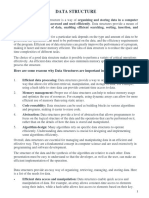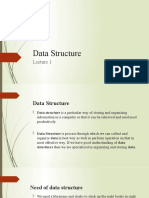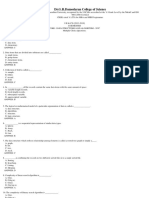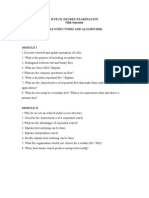0% found this document useful (0 votes)
8 views4 pagesConcept of Data Structure
Data structures are methods for organizing, storing, processing, and retrieving data based on specific requirements. Common types include arrays, stacks, queues, linked lists, trees, graphs, and hash tables, each serving different purposes in software development. They are widely used in applications such as databases, web development, GPS navigation, search engines, and cybersecurity.
Uploaded by
Nicky NtonganiCopyright
© © All Rights Reserved
We take content rights seriously. If you suspect this is your content, claim it here.
Available Formats
Download as PDF, TXT or read online on Scribd
0% found this document useful (0 votes)
8 views4 pagesConcept of Data Structure
Data structures are methods for organizing, storing, processing, and retrieving data based on specific requirements. Common types include arrays, stacks, queues, linked lists, trees, graphs, and hash tables, each serving different purposes in software development. They are widely used in applications such as databases, web development, GPS navigation, search engines, and cybersecurity.
Uploaded by
Nicky NtonganiCopyright
© © All Rights Reserved
We take content rights seriously. If you suspect this is your content, claim it here.
Available Formats
Download as PDF, TXT or read online on Scribd
/ 4




















































































